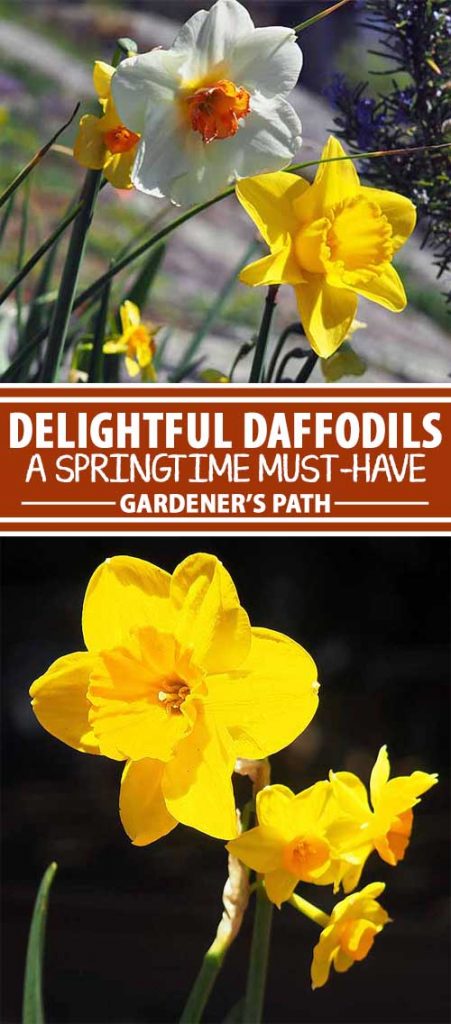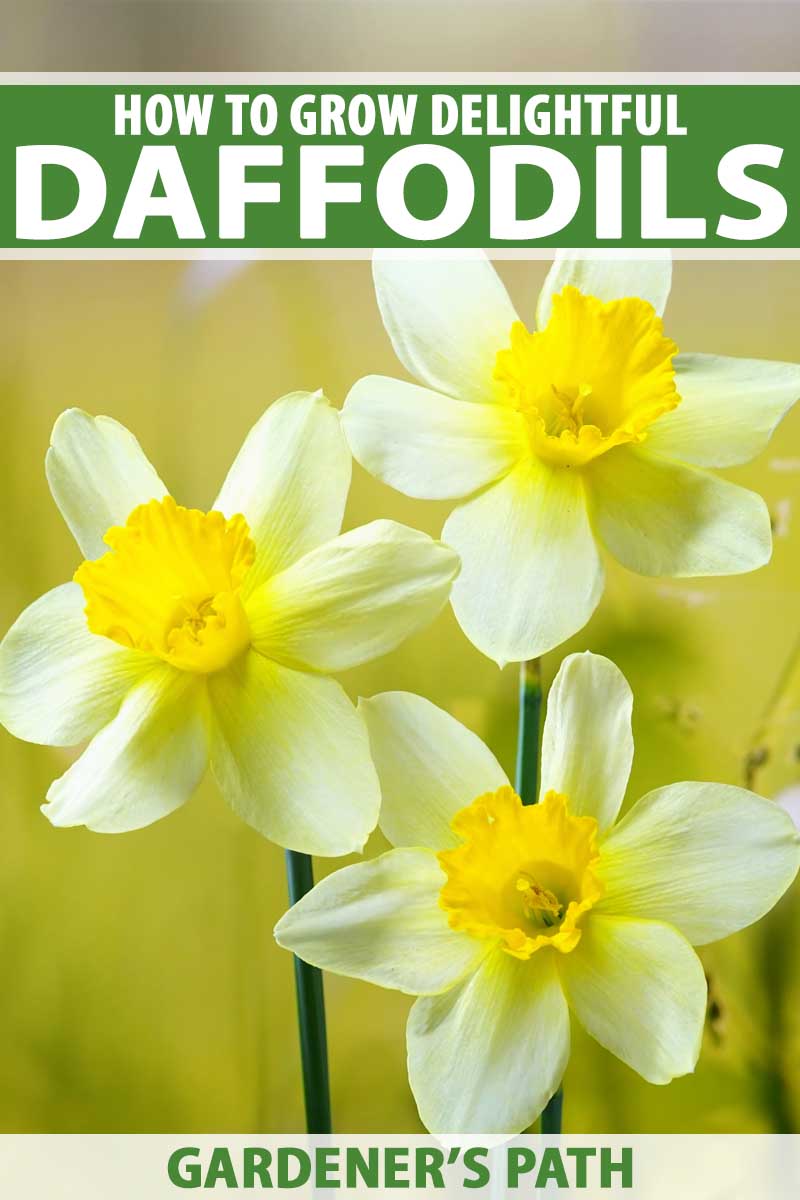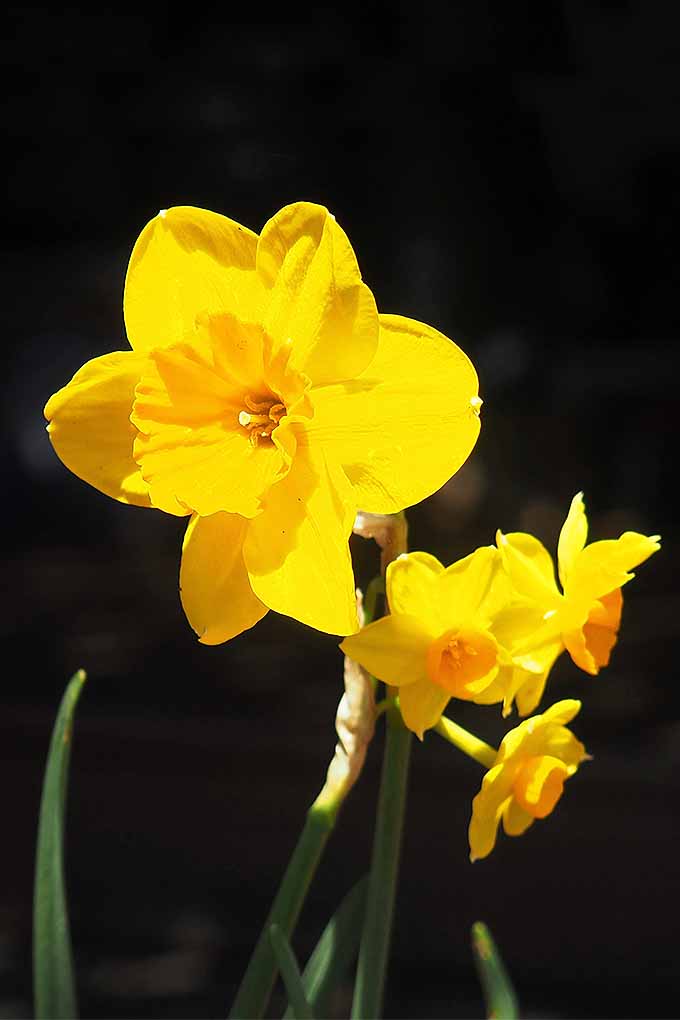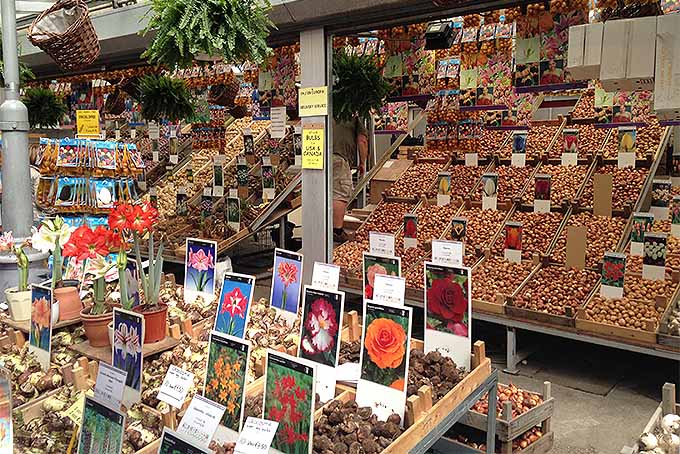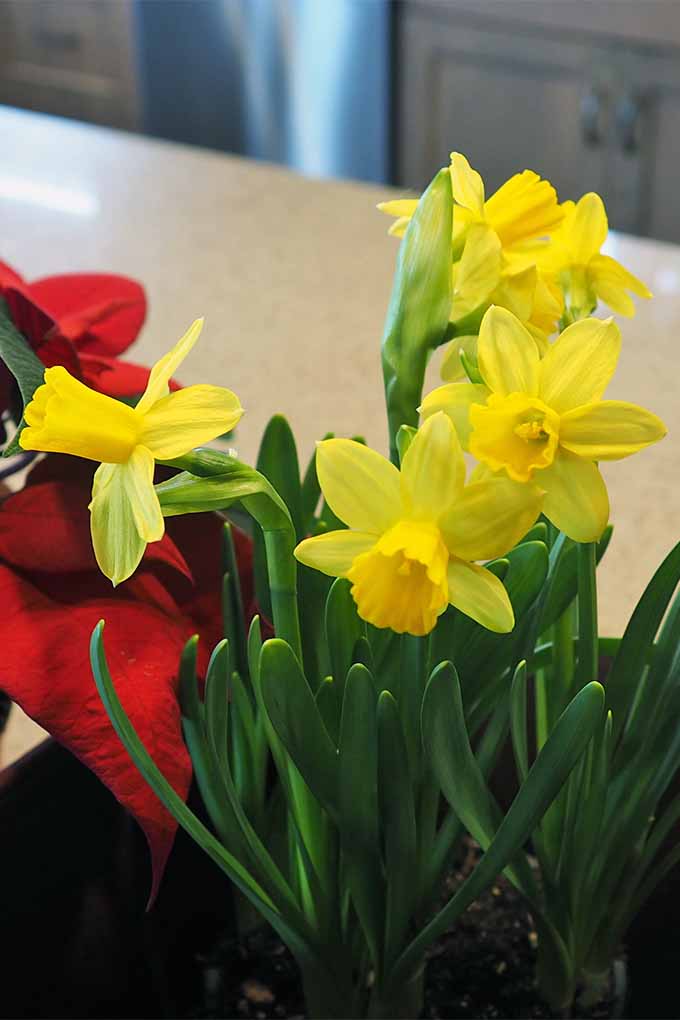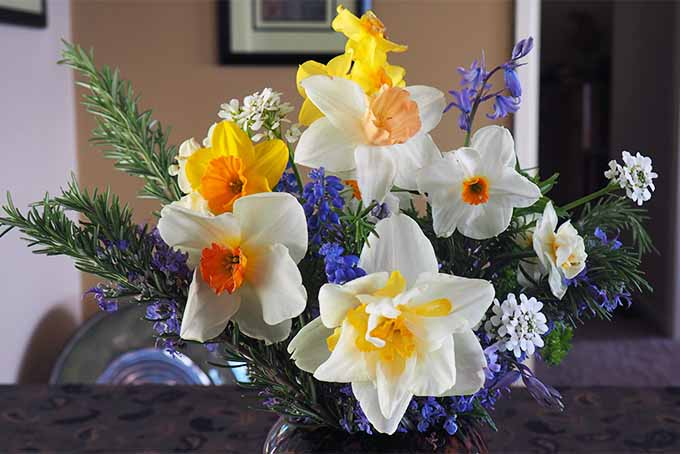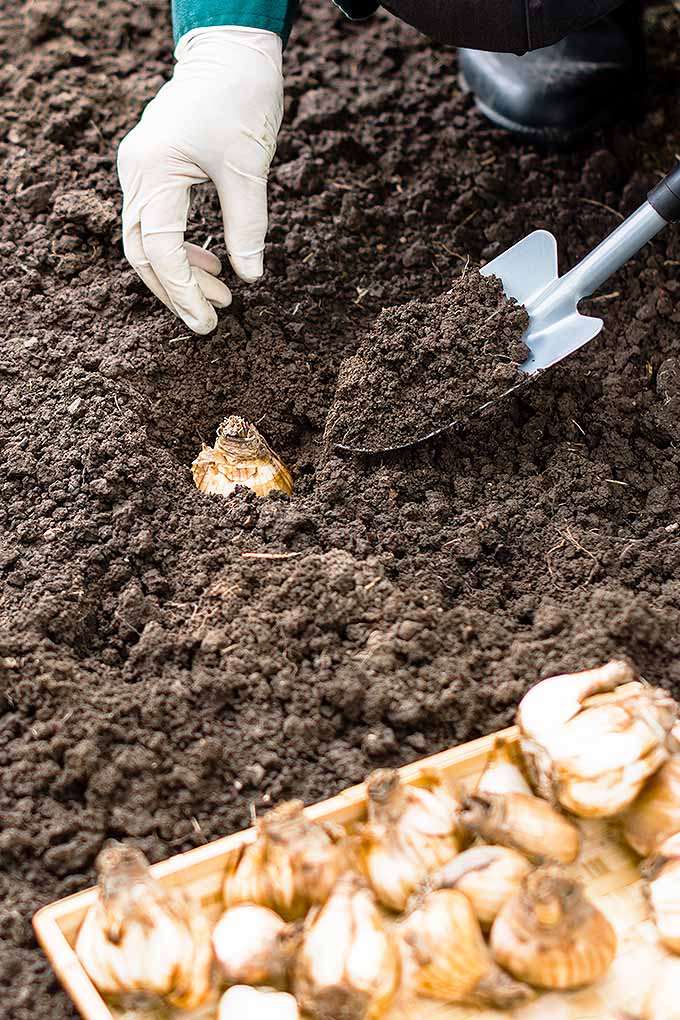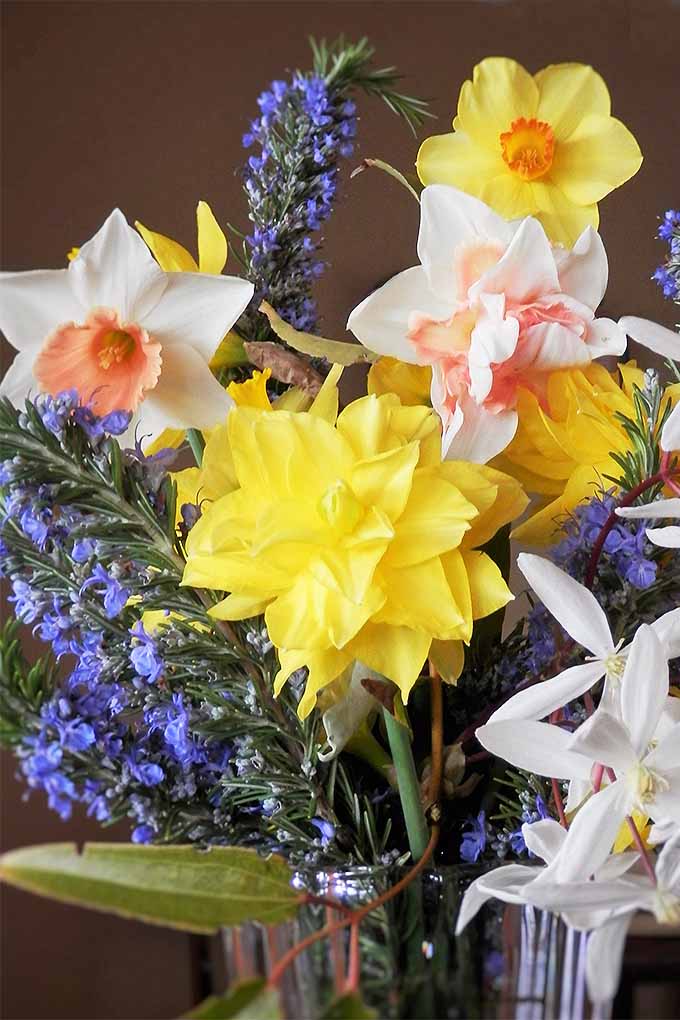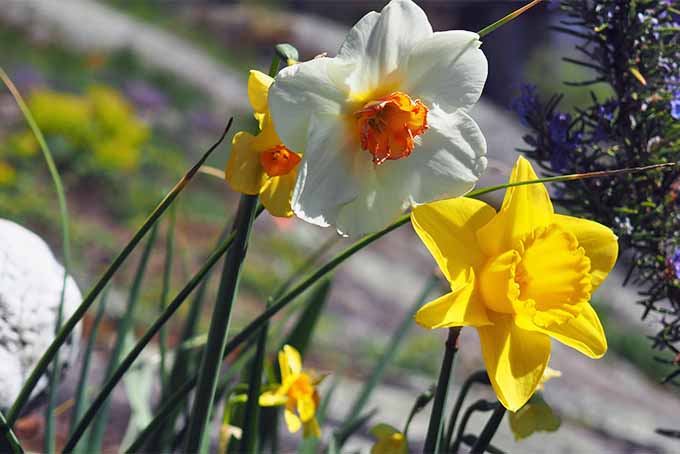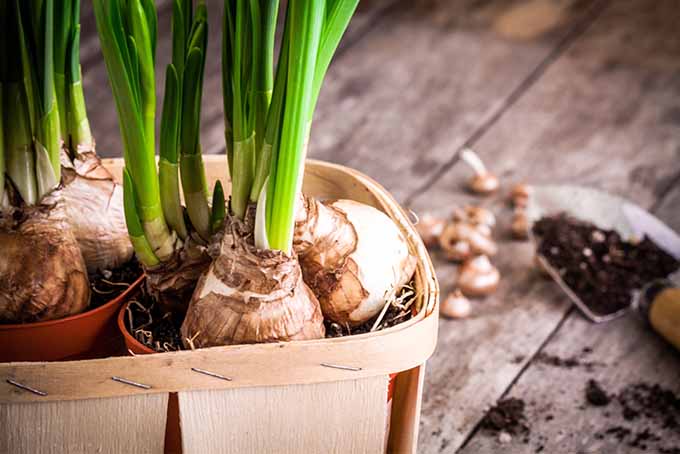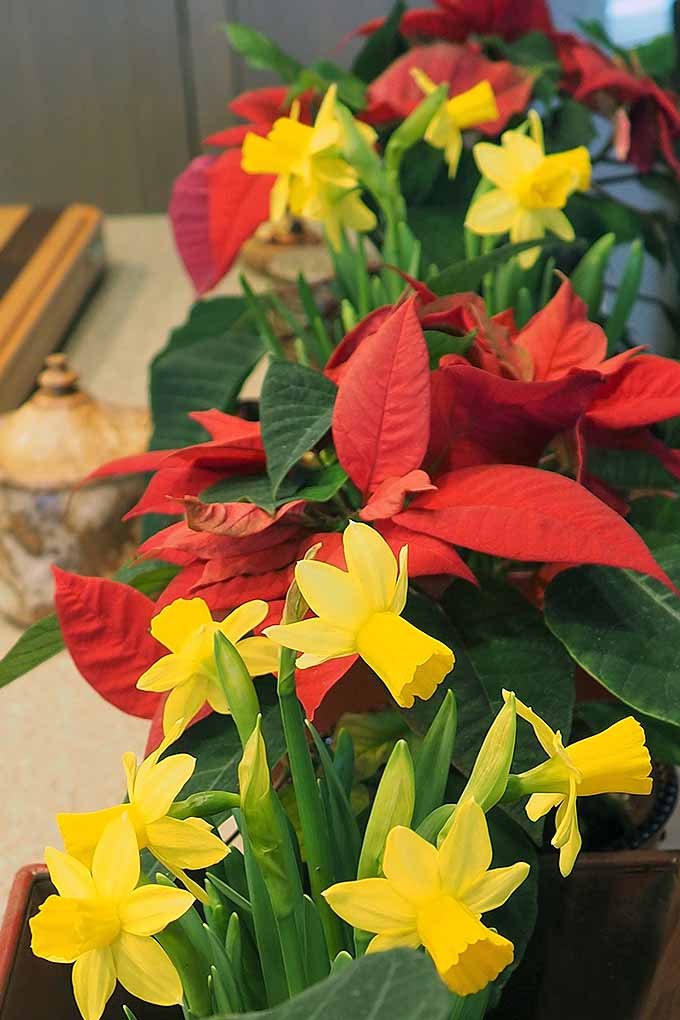The flowers are notable for their hues of yellow or white, but many garden varieties also come in shades of pink, coral, and orange. The central corona is trumpet or cup-shaped, and is surrounded by six petals (technically, tepals). Petals can be the same shade as the corona, have the same color but of a different intensity, or be strikingly two-toned. Of the genus Narcissus in the Amaryllidaceae (amaryllis) family, other common names for these spring favorites are narcissus and jonquils. We link to vendors to help you find relevant products. If you buy from one of our links, we may earn a commission. According to Roman naturalist/author Pliny the Elder, etymology of the word narcissus comes from the Greek narkao (narcotic) – referring to the addictive effect of its beguiling perfume – and not for the mythological Greek youth who pined for his own reflection in a pool of water. Described by Swedish botanist Carl Linnaeus in his Species Plantarum, narcissus cultivation became widely popular in Europe in the fifteenth century. And by the late 1800s, bulb production had become a lucrative commercial trade in the low countries of northwest Europe, mostly the Netherlands. The favored habitat for this perennial flower includes open areas such as grasslands, hillsides, marshes, pastures, riverbanks, scrub, and woodlands. Daffodils have a slight preference for lightly acidic soil, and with the exception of N. tazetta, bulbs require extended exposure to cold temperatures to initiate spring growth. Propagation can be done through seed collection, but this process is considered too time consuming for commercial growers. A more efficient model is through the development of baby bulbs, or offsets, that can be split and planted. Propagation can also be achieved through the process of basal division, by coring, scooping, scoring, or sectioning bulbs. Celebrated in art and literature, and the featured flower of many spring festivals, daffodils make a striking ornamental plant in the garden or when naturalized in lawns, meadows, and woodland settings.
Vary Varieties for a Longer Season
Daffodils come in numerous varieties, from dainty miniatures such as ‘Tete-a-Tete’ to large, traditional standards like the regal ‘King Alfred.’ Longevity of bloom times varies by species and local conditions, but generally ranges between 5 and 20 days. Bloom periods vary as well, ranging from mid-January to mid-May. This means, depending on how long and intense your winters are, that you can enjoy them for up to four months! When purchasing, check the label for ‘early,’ ‘mid,’ or ‘late’ bloom times and select some from each group to prolong the growing season. For greater visual impact, plant daffodils with similar bloom times together rather than mixing them. For example, the following selection would give four months of flowers: ‘Rijnveld’s Early Sensation’ blooms as early as mid-January, ‘Spellbinder’ blooms in March and April, and ‘Pheasant’s Eye’ blooms from mid-April into May.
Finely Fragrant
Most varieties have some degree of fragrance that ranges in intensity form mild to deep, with scents that can be citrusy, floral, fruity, or spicy. All Star Narcissus Mix For a bright blend, try a variety pack. An “All Star” mix is available from Eden Brothers in packages of 10,20, 50, and 100 bulbs. ‘King Alfred’ A traditional early-season standard is the stately, all-yellow ‘King Alfred’, and it’s available in packages of 10, 20, 50, and 100 bulbs from Eden Brothers. Pretty in Pink Mix Or, for something really unique, try this Pretty in Pink variety pack available from Eden Brothers. Choose from packages of 10, 20, 50, and 100 bulbs. If you’d like to extend your daffodil growing season, try this “Eight Weeks of Daffodils” mix, available from Dutch Grown. This variety pack contains a mix of early-, mid-, and late-blooming varieties in bright yellow, with large trumpet-shaped blooms. 8 Weeks of Daffodils Find packages of 50 to 5,000 bulbs at Dutch Grown. Take a look at our “15 of the Best Daffodil Cultivars for Naturalized Plantings” for more varieties. And as they’re excellent as a cut flower, you’ll want to plant plenty to bring some indoors for their lovely color and perfume. Try these tips for keeping your vase of flowers fresh for as long as possible. Some, like the Poet’s daffodil, N. poeticus, have a full, sweetly citrus fragrance that will quickly fill a room with just a couple of blooms. ‘Hawera’ has a deep, musky scent. And ‘Grand Soleil d’Or’ is grown commercially for its essential oil that has sweet tones of bitter orange. For forcing indoors, popular varieties include the miniatures such as the double-flowered ‘Bridal Crown’ – long-lasting on a cool windowsill, its heady fragrance is sweetly jasmine-like.
Planting Procedures
When planting in the garden, use the following outline to cultivate your own profuse display of flowers:
Select high-quality bulbs that are large, plump, and firm, rejecting those that are small, shriveled, or soft.Choose a selection of early, mid, and late-season varieties for flowers from late winter into mid-spring.Small varieties are ideal for borders, planters, spring containers, indoor forcing, and they can make a delicate statement when naturalized in lawns and under trees.Planting should be done in the fall and can continue until 2-4 weeks before cold weather freezes the soil – or around mid-December if you don’t get extended freezing temperatures.A range of soils are suitable, but daffodils prefer a moderately fertile, well-drained location.Remember to plant plenty to bring indoors for bouquets!Choose a garden site that offers full to part sun.
Keep the soil moist during the growing season, and after blooms are finished as well.Before planting, break up compacted soil with a garden fork and work in a generous amount of organic material such as mature compost, worm castings, or well-rotted manure.A good rule of thumb is to plant bulbs 2-4 times deeper than they are long, or approximately 4-6 inches deep.Plant with the root end down, pointy end up, in holes or trenches sprinkled with bone meal.For a striking display, plant daffodil bulbs in large groups approximately 2-6 inches apart rather than in a single row. These flowers are especially appropriate for mass planting.For planting in pots and planters, spacing can be a little more compact.Leave any mulch materials in place as shoots break through the ground – they’ll still benefit from protection against cold weather.
Care and Cultivation Tips
Aside from their beauty in the garden, naturalized daffodils are utterly charming in lawns, in uncultivated areas of rough grass, or under deciduous trees. For lawn planting, avoid making near, orderly grid arrangements, which can look stiff and stilted. For a more natural look, cast the bulbs over the area and plant them where they land. For details on designing your layout, see our guide: How to Create a Naturalized Daffodil Planting.
After blooms are finished, avoid mowing until summer arrives to allow bulbs to receive needed nutrients via their leaves. According to the American Daffodil Society, mature daffodils should be fertilized as leave tips emerge in the spring. This won’t affect this year’s flower production, as the signal to form flowers for next year happens after they’ve finished blooming, but it can give the plants the extra boost that they need after making it through the long winter. Garden Weasel Bulb Planter In areas with milder cold seasons, other gardening experts recommend fertilizing after leaves have died back in the fall. Whatever you choose to do, we do not advise fertilizing daffodils twice a year. We have an additional guide that details our daffodil fertilization recommendations. For better mixing with other plant species, be sure to check out our daffodil companion planting guide.
Pot Up in Planters
All varieties of narcissus can be grown in containers, and bring a welcome splash of vibrant spring color to patios and decks. Ensure your planter has plenty of drainage material and fill approximately two-thirds of the way with fertile soil amended with mature compost or well-rotted manure and some bone meal. Planting depth is the same, about four inches, but spacing can be much tighter in pots – up to only one-half inch between them. Top up with soil, covering the bulbs with a 3-inch layer. Water well while they’re growing, and enjoy the cheerful blooms with their lovely fragrance. You might want to dig up your daffodils after they’ve died back, to reuse a container or garden location for late spring or summer plantings that require a planting hole greater than the depth of the bulbs. Wait to dig them up until after the leaves have died, and follow the instructions described in the next section.
After-Flower Care
Once flowers have faded, dead-heading is recommended. This will ensure energy goes into building a strong bulb, and not into forming seeds. And although their foliage gets a little messy looking as it wilts and yellows, resist the urge to cut back or tie up the leaves. Tying creases the delicate plant cells and causes a disruption in the transfer of energy from the sugars formed in photosynthesis. If you find their sprawl to be irksome, use a plant clip to attach them to a small stake and neaten their appearance. Add a layer of organic material at the base of the leaves to supply nutrients and keep moisture inside. Water regularly throughout the summer and fall if conditions are dry. A slow-release granular fertilizer can also be applied at this time. Before winter sets in, ensure your bulbs have at least three inches of soil on top to prevent frost heaving and damage from cold. Cycles of freezing and thawing cause contractions of the soil, and may bring your bulbs to the surface if they haven’t been planted deeply enough. If you live in an area with particularly wet weather or you’ve had issues with the wildlife digging up your plants, you do have some options. Though it’s more common to leave them in the ground after blooming until they come up again in the spring, bulbs can be dug up after they go dormant, and stored until fall planting. When blooms are finished, deadhead and allow the leaves to die back as usual. Keeping the leaves intact also helps to find the bulbs when it’s time to dig! Dig them up, being very careful to avoid causing any damage to the bulbs. Allow them to dry, and store them in a cool, dry, and dark location in trays of sand or peat, or hanging in a mesh bag. Good airflow is key to prevent mold and rot, though some gardeners recommend sprinkling your stash lightly with water once a month until it’s time to plant again. Some people who use this method also like to chill them in the fridge. Just be sure to label them clearly – you don’t want a bleary-eyed chef cutting into your bulbs! When planting season arrives, check the bulbs that you’ve stored carefully for damage or signs of decay, and dispose of any poor specimens before replanting.
What if They’re not Flowering?
Maybe you’re familiar with this unfortunate scenario: ‘Daffodil blindness’ occurs when leaves emerge in the spring, but flowers never form. Daffodils, like many plants, can be sensitive if they’re not growing in the right conditions. There are several common causes of a lack of narcissus blooms, and we’ve described these below, along with simple, straightforward solutions. Let’s take a look!
Too much shade… Move to a location where they’ll get at least three hours of sunlight each day.Dry soil conditions before and after flowering… Daffodils need regular watering to form flowers.Removing or tying up foliage after blooming…. Leaves are needed to transfer energy, so leave them in place or clip to a stake to neaten.Allowing seed heads to form… Concentrate energy to the bulb by deadheading spent blooms before seed heads develop.Lack of nutrients… Ensure your soil has plenty of organic humus, top dress with compost or manure in spring, and use a slow-release fertilizer for flowers once leaves emerge.Shallow planting… Planting too close to the surface of the soil can result in bulb division instead of flower formation. Ensure bulbs are under a layer of soil that’s at least three inches deep.Overcrowding… Planting too closely or failing to divide plants can also result in poor displays. Dig up and re-space them to two bulb widths apart.
Read more about why daffodils may not bloom here.
Force Indoors for Winter Color
To enjoy their color and fragrance indoors over the winter months, daffodils, and other bulbs like amaryllis and hyacinths, can be forced to bloom early indoors.
Pests and Problems
Daffodils are easy to grow with naturally robust health, but a few problems can occur, with fungi and gastropods being the main culprits. Ziva Paperwhite Narcissus – Indoor/Very Fragrant
Indoor narcissus can be forced in a soil mix, or grown with just water using a pebble base. Here’s what you need to do:
For both mediums, plant several bulbs per pot with the widest parts almost touching.In soil, use a good multi-purpose potting blend or coconut fiber (coir) with the tips planted just below the surface.
In water, nestle their bases into a container of pebbles, then fill just until the water reaches the widest point of the container.Place in a warm, sunny spot and water regularly.Have supports ready, as the foliage can sprawl.Enjoy your early indoor display of springtime!After blooming in soil, leave pots in a cool, frost-free site to die down, then plant outdoors and they’ll bloom again in 1-2 years.Daffodil bulbs forced in water aren’t viable for going into the garden, and should be composted when they’re finished.
Bacterial infections are rare, but fungi such as Fusarium oxysporum can be an issue, causing bulb rot and yellowing of the leaves. Remove and safely discard infected plants immediately. It’s important to burn them or dispose of them in the same way you would get rid of other infectious refuse – don’t put them on the compost pile. Don’t replant in the same spot for the next five years, or replant with resistant varieties such as N. triandrus, N. tazetta or N. jonquilla. Slugs and snails enjoy munching on tender leaves and can be dealt with in several natural ways, conveniently outlined in this article. On the plus side, narcissus is wonderfully resistant to deer and rodents – a great option if Bambi and Rocky the squirrel stop by to enjoy a tulip feast! Remember to select a variety of bloom times to ensure a long season, include fragrant selections, and plant enough to enjoy as a cut flower – because they’re absolutely irresistible! For even more fun, try your hand at forcing some indoors in the winter – you’ll love the results! Still not sure about forcing bulbs? For step-by-step instructions, check out our article on forcing spring blooms indoors. Do you folks have any comments or questions about the delightful daffodil? If so, shoot us a line in the comments below! And for more springtime blossom ideas, take a peak at some of our other growing guides such as:
How to Grow and Care for Crocus FlowersHow to Grow Irises for Fragrance and ColorHow to Grow Hardy Snowdrops (Galanthus)

